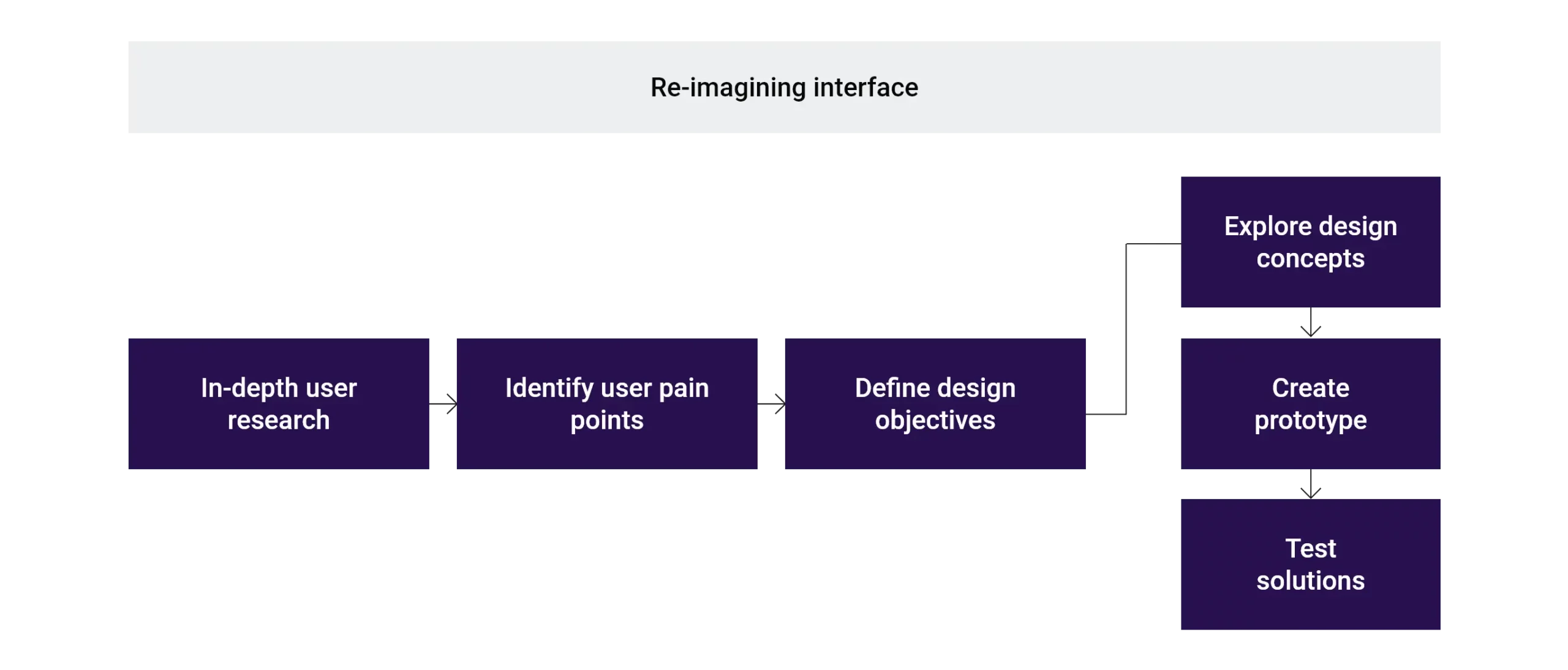User interface (UI) and user experience (UX) design are constantly evolving disciplines driven by the need to create engaging and user-friendly digital experiences. As technology advances and user expectations change, there are different approaches designers can take to refresh and improve interfaces. In this article, we will delve into the UI / UX design process and understand the concepts of re-imagining, re-skinning, and re-creating, and how they contribute to the evolution of digital products.
Re-imagining: Unleashing Innovation and User-Centric Design
Re-imagining in UI/UX design involves a holistic approach that goes beyond incremental changes. It is about rethinking and redefining the entire user experience to address pain points, introduce innovative solutions, and meet emerging user needs. Re-imagining encourages designers to think creatively, challenge assumptions, and re-imagine the possibilities.
When re-imagining an interface, designers conduct in-depth user research, identify user pain points, and define clear design objectives. They then explore new design concepts, create prototypes, and test innovative solutions. Re-imagining often leads to significant changes in an interface’s structure, layout, and functionality, resulting in a transformed user experience that better aligns with user expectations. Sometimes re-imagining involves changing the user interface, and sometimes it requires changing the entire process that the user follows.

Re-skinning: Refreshing the Visual Experience
Re-skinning, also known as a facelift or visual overhaul, focuses on updating the visual elements of an existing UI without making significant changes to the underlying functionality. It is often employed when an interface looks outdated or no longer aligns with current design trends.
During re-skinning, designers update the color schemes, typography, icons, and other visual elements to give the interface a fresh and modern look. Re-skinning helps maintain visual consistency, align the interface with brand guidelines, and enhance the overall aesthetics. It is a cost-effective approach that can breathe new life into an interface and improve user perception without requiring extensive development work.

Re-creating: Transforming for Optimal User Engagement
Re-creating involves a comprehensive redesign of the UI and UX, going beyond visual changes. It is employed when an interface requires significant improvements, such as addressing usability issues, rethinking the information architecture, or introducing new features. During the re-creating process, designers conduct user research, redefine the user flow, and create wireframes and prototypes to test and validate new design concepts. The goal is to optimize the user experience by improving usability, enhancing navigation, and introducing innovative solutions. Re-creating often requires a more significant investment of time and resources compared to re-imagining or re-skinning. It offers the opportunity to transform the interface into a more intuitive, user-friendly, and engaging experience, resulting in increased user satisfaction and improved business outcomes.

Understanding the Spectrum
Re-imagining, re-skinning, and re-creating represent different approaches on a spectrum of UI/UX design evolution. They cater to different needs and objectives, depending on the current state of the interface and the goals of the design project. Re-imagining is about embracing innovation, challenging conventions, and pushing boundaries to create transformative experiences. It is ideal when the existing UI requires a fundamental redesign to address user pain points and introduce cutting-edge solutions.
Re-skinning focuses on refreshing the visual elements of an interface to give it a modern and updated look. It is suitable when the existing UI is visually outdated but still functions well, and the primary objective is to enhance aesthetics and maintain consistency.
Re-creating involves a comprehensive redesign encompassing an interface’s visual and functional aspects. It is the right approach when the existing UI has significant usability issues or requires a complete overhaul to align with current user expectations and business objectives.

Choosing the Right Approach
When considering which approach to take in a UI/UX design project, it is essential to assess the current state of the interface, understand user needs and pain points, and define clear design objectives. Re-imagining is ideal when a radical transformation is needed to address user pain points, introduce innovation, and create a truly user-centric experience. It requires a deep understanding of users, careful analysis of data, and an open-minded approach to design thinking. Re-skinning is suitable when the existing UI still functions well but needs a visual facelift to align with current design trends and brand guidelines. It is a surface-level approach that focuses more on improving aesthetics and maintaining consistency. Re-creating is the right choice when the existing UI has significant usability issues, lacks scalability, or requires a complete redesign to meet evolving user needs. It involves a more extensive and time-consuming process but can result in a transformative user experience. In the end, the selection of a strategy relies on the goals, constraints, and context of the design project. UI/UX designers must carefully evaluate the needs and objectives and select the most appropriate approach to drive meaningful improvements and create exceptional digital experiences.
Conclusion
Re-imagining, re-skinning, and re-creating represent different approaches in the UI / UX design process, each with its unique focus and objectives. Re-imagining encourages innovation and user-centric design thinking, re-skinning refreshes the visual experience, and re-creating involves a comprehensive redesign to optimize user engagement. By understanding the spectrum of design evolution and selecting the appropriate approach based on the specific project requirements, designers can create interfaces that meet user needs, align with business objectives, and deliver exceptional user experiences.












